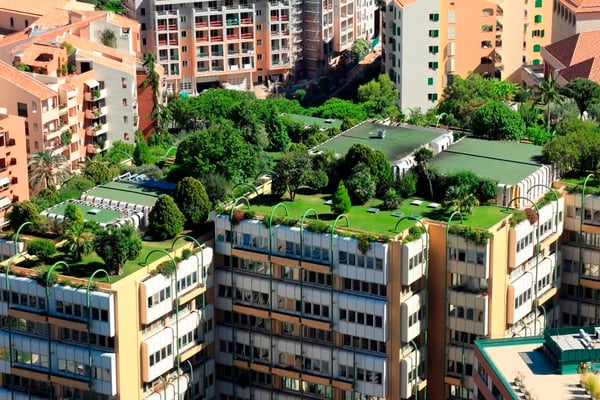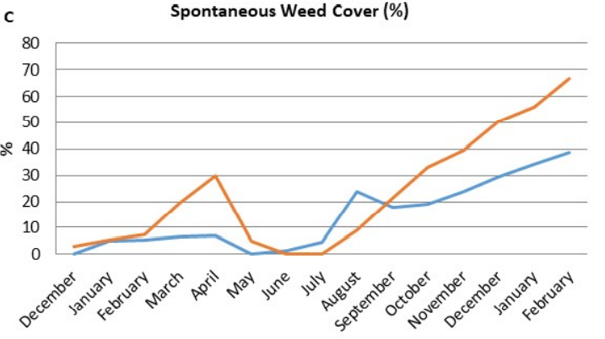Imagine the conditions on the roof. Usually tiny plants must cope with unequal rainfall distribution, intense solar radiation, heavy evapotranspiration, limited water supply, strong stormwater events, daily and seasonal strong temperature fluctuations, flash flooding, freeze and thaw cycles, and exposure to wind. All and more of that, on very limited substrate depth. Appropriate choice of green roof system components is one of key success factors for plants survival on the rooftop.

Green roofs should be designed to depend primarily on the rainfall as their primary water source (FLL 2008). Not every climate or every roof enables that. So it is important to develop strategies in design, construction, plant selection, and maintenance to enhance green roof drought tolerance (ASTM International, 2014).
Plants which can cope with such conditions on the roof must be harsh and capable of survival in such tough environment. Very well-known selection of rooftop plants includes sedums. Researchers already confirmed in the past, what we have seen in the practice: succulents can sustain in shallower and less nutrient rich substrate, while other plants require deeper substrate with additional organic matter and irrigation (Monterusso, et al., 2005). Rowe et al (2012) also reveal that the plants which were able to survive in shallower substrates, formed stable communities after several years.
Rooftop substrate choice will influence the plant viability heavily in specific climate conditions. An ideal growing medium for plants can sustain plant life, require little input and does not break down easily (ASTM International, 2014). When visiting green roofs in, one can often observe beside substrate compaction, also drying out of organic matter and its subsequent hydrophobia, heavy erosion effects and change of particle size distribution. In certain cases, this can be partially compensated with deeper substrate bed on rooftop, but that also means greater demand on structural load-bearing capacity on the roof, and larger pressure on runoff quality, which will be further discussed in our future blogs. Substrates are one of the key factors for the rooftop long-term success. Many researchers show that substrate depth can play important role (Ondono et al., 2016; Schneider et al., 2014; Savi et al., 2016) while some emphasize more the role of substrate compositions (Razzaghmanesh et al., 2014) and/or combination of the two.
Urbanscape® green roofs offer lightweight and long term solution for rooftop plants success. Urbanscape® Sedum-mix blanket is installed on the top of specifically designed layer, well known under brand name Green roll. More details about extensive Urbanscape® green roof are available here.
What is a Green roll and what it does?
It is manufactured from the mixture of various rock components (such as basalt), and during manufacturing process, thin fibres on fast rotating wheels (spinners) are bound with needling punch for dimensional stability. Therefore, no binder is used in the production process of this material and the likelihood of water characteristics being changed in uncontrolled environment on the rooftop, is eliminated.

On the base of our long term experience, we designed specifically for green urban infrastructure, the lightweight layer up to 40 mm depth, made from pure rocks, which
- offers a readily available water storage for plants (more then 90% of this water is easily available for plant uptake, measured with pF curve)
- act as water reservoir while supporting plants through their life cycle
- sustains porous structure through time
- does not have classical substrate-related issues with particle size distribution or erosion effects
- sustains plant life, require minimum input (irrigation when needed) and does not break down easily
- does not increase demand on structural load-bearing capacity on the roof
- does not increase the burden of pollutants in the water runoff
Interesting facts about Urbanscape® extensive green roof system:
- lightweight solution, easy to install
- lightweight solution, easy to maintain
Why easy to maintain? Because it offers just the right environment for rooftop plants (sedum) success, and not the optimal conditions for invasive species (weeds). Weeds need deeper place to root in and more organic matter for their survival and further development. In graph bellow, you can see the weed appearance in green roof systems, containing Sedum mix blanket with additional substrate layer of 5cm (orange line) versus green roof system without additional substrate layer (blue line). This experiment was carried out by University of Lleida, in Mediterranean climate zone (2019-2021). For the purpose of the research, no weed removal was carried out during the experiment.
 Graph: Average spontaneous weed cover (%) in green roof systems with additional substrate layer (orange line) compared to green roof system without additional substrate layer (blue line). No weed removal. Internal KI report, 2022.
Graph: Average spontaneous weed cover (%) in green roof systems with additional substrate layer (orange line) compared to green roof system without additional substrate layer (blue line). No weed removal. Internal KI report, 2022.
Literature:
-
ASTM International, 2014. ASTM E2777-14, Standard Guide for Vegetative (Green) Roof Systems (West Conshohocken, PA, US).
-
FLL, 2008. Guidelines for the Planning, Construction and Maintenance of Green Roofing, Forschungsgesellschaft Landschaftsentwic. Bonnklung Landschaftsbau e.V.- FLL, Bonn
- Internal KI report 2022. Overview of research findings on green roof systems in Mediterranean climate zone. How to use them in practice and future recommendations
-
Monterusso, M.A., Rowe, D.B. and Rugh, C.L. (2005) Establishment and Persistence of Sedum spp. and Native Taxa for Green Roof Applications. HortScience, 40, 391-396.
-
Ondono, S., Martínez-Sánchez, J.J., Moreno, J.L., 2016. The composition and depth of green roof substrates affect the growth of Silene vulgaris and Lagurus ovatus species and the C and N sequestration under two irrigation conditions. J.Environ. Manage. 166, 330–340.
-
Razzaghmanesh, M., Beecham, S., 2014. The hydrological behavior of extensive and intensive green roofs in a dry climate. Scinece of the Total Environment 449: 284-296.Rowe, D.B., Monterusso, M.A., Rugh, C.L., 2006. Assessment of heat-expanded slate and fertility requirements in green roof substrates. Hort Technology 16 (September): 471–477.
-
Rowe, D.B., Getter, K.L., Durhman, A.K., 2012. Effect of green roof media depth on Crassulacean plant succession over seven years. Landscaping and Urban Planning 104 (3–4): 310–319.
-
Savi, T., et al., 2016. Drought versus heat: what is the major constraint on Mediterranean green roof plants? Sci. Total Environ. 566–567, 753–760.
-
Schneider, A., Fusco, M., Bousselot, J., 2014. Observations on the survival of 112 plant taxa on a green roof in a semi-arid climate. J. Living Archit. 1 (5), 10–30.


